|
 
 
 e-mail
: cmct@chiangmai-online.com e-mail
: cmct@chiangmai-online.com
[Chiang Mai Carnival Tour T.A.T. LICENSE 23-0137
chiangmai-carnival.com]
Wat Suan
Dok and Wat Chet Yot
The most photographed and most inspiring temples of Chiang Mai: Wat
Suan Dok: built in a 14th century pleasure garden -- and Wat
Chet Yot: built in 1447 by Lanna architects recently returned from
Buddhagaya, the site of the Buddha's enlightenment in northern India over
2,500 years ago.
Wat
Suan Dok
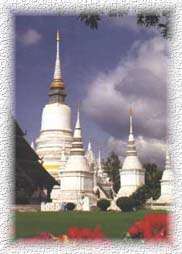 Wat
Suan Dok (the Flower Garden Temple) was originally built in the 14th century (1383) as a Thai monarch's pleasure garden. Legend says that its chedi contains one half of a glowing gem unearthed in Sukhotai by a Sri Lankan monk - the other half being buried in Doi
Suthep. In the courtyard to the west, next to an elegant chedi built
in 1372, is a garden of several resplendent white chedi containing
the ashes of Chiang Mai's royal family. The 500 year old bronze Buddha image
in a secondary chapel is one of northern Thailand's largest metal images.
The temple is a favourite spot for photographers, due to its particularly
striking sunsets.. Wat
Suan Dok (the Flower Garden Temple) was originally built in the 14th century (1383) as a Thai monarch's pleasure garden. Legend says that its chedi contains one half of a glowing gem unearthed in Sukhotai by a Sri Lankan monk - the other half being buried in Doi
Suthep. In the courtyard to the west, next to an elegant chedi built
in 1372, is a garden of several resplendent white chedi containing
the ashes of Chiang Mai's royal family. The 500 year old bronze Buddha image
in a secondary chapel is one of northern Thailand's largest metal images.
The temple is a favourite spot for photographers, due to its particularly
striking sunsets..
(*)Transportation by air-con. minibus
(**)Transportation by air-con. car
Wat
Chet Yot
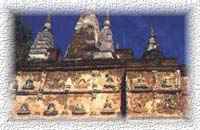 The
unusual seven-spired square chedi of Wat Chet Yot is a duplicate
of the Mahabodi Temple in Buddhagaya, the site of the Budha enlightenment
in northern India over 2,500 years ago. It was built in 1447 by Lanna architects
on the order of King Tilokaraja. The 8th World Sangkayana (Doctrines revision
- 8th World Buddhist Council) was held in this temple at that time - attended
by more than 100 monks from various countries. Unfortunately, the temple
was damaged in 1566 when the Burmese invaded Chiang Mai. The
unusual seven-spired square chedi of Wat Chet Yot is a duplicate
of the Mahabodi Temple in Buddhagaya, the site of the Budha enlightenment
in northern India over 2,500 years ago. It was built in 1447 by Lanna architects
on the order of King Tilokaraja. The 8th World Sangkayana (Doctrines revision
- 8th World Buddhist Council) was held in this temple at that time - attended
by more than 100 monks from various countries. Unfortunately, the temple
was damaged in 1566 when the Burmese invaded Chiang Mai.
Chiang Mai
National Museum
Chiang Mai National Museum (open Wednesday through Sunday) provides
a superb overview of Lanna Thai Culture including works of art, war weapons
and ancient Buddha images.
Among its prize exhibits is a huge Chiang Saen-style bronze
Buddha head 3m (10 ft) tall and a beautiful footprint inlaid with intricate
mother-of-pearl.
The museum also offers a varied assortment of Northern artifacts
ranging from hilltribe costumes to implements used in hilltribes
(cf.Doi Suthep Road) daily life.
Kruba
Srivichai Monument and Wat Phrathat Doi Suthep
A steep road meandering for 12 km (7.5 miles) up the flanks of the mountain ('Doi') leads to Doi
Suthep - the beautiful and cool location of Wat
Prathat and the Royal Winter palace west of Chiang Mai. On the way,
Kruba
Srivichai Monument (which honours the "Engineer Monk" whose followers built the
first motor road up the mountain in 1935) is a popular halting-place where you can pay your respects and perhaps say a prayer.
Kruba
Srivichai Monument
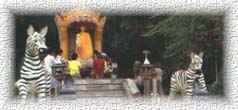
Situated 7 kms from town, the monument
was built to commemorate Kruba Srivichai, who saw the hardship of the climb
and initiated a plan to construct a road up Suthep Mountain to the temple and monastery.
The man and therefore the monument are highly popular among the local Thais
who regularly come here to make wishes. If the wishes come true, the wisher
will return and present flowers or wooden elephants in thanks for the bounty
provided.
Wat
Prathat Doi Suthep
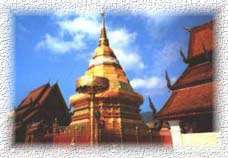 Wat Prathat Doi Suthep, perched high on the flank of Suthep
Mountain, 1,022 m (3,000ft) above sea level, is Chiang Mai's most famous
temple. The pagoda in its centre contains some of the relics of the Lord
Buddha. The temple is visited thoughout the year by thousands of tourists
and Buddhist pilgrims from all over the world. Wat Prathat Doi Suthep, perched high on the flank of Suthep
Mountain, 1,022 m (3,000ft) above sea level, is Chiang Mai's most famous
temple. The pagoda in its centre contains some of the relics of the Lord
Buddha. The temple is visited thoughout the year by thousands of tourists
and Buddhist pilgrims from all over the world.
(*)Transportation by air-con. minibus
(**)Transportation by air-con. car
According to legend, the temple's site was selected by an auspicious elephant.
The story goes that a monk named Sumana placed half of a Buddha relic on
an elephant's back and set it loose. It was decided that when the elephant
stopped walking, a temple would be built on that exact spot to house the
gem ... Instead of stopping at an easy site, the elephant began climbing
the hill - and finally paused on the brow. This was where Wat Prathat Doi
Suthep was built by King Kuna in 1388...
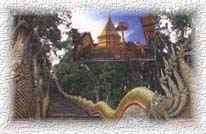
The temple is approached by climbing a steep
Naga (serpent) staircase comprising 304 steps (however, you can also ascend
by funicular railway).
Phuping
Palace
After Doi Suthep, the road continues to climb through pine forest to Phuping Palace on Doi
Buak Ha, 22 kms from town. Phuping Palace, built in 1962, is a summer residence
of the royal family, used as headquarters for overseeing development projects
in northern Thai and hilltribe villages. The beautiful flower
gardens (cf.Northern Route) are open to the public from 8.30am to 4.00pm
Friday to Sunday and on official holidays.
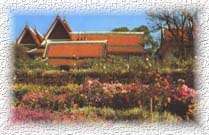
Wat Ku-Tao,
Wat Chiang Man, Wat Chedi Luang, Wat Phra Sing
Wat
Ku-Tao: the most tranquil temple of Chiang Mai, Wat
Chiang Man: the oldest, dating from 1296, Wat
Chedi Luang: the most impressive, and Wat
Phra Sing: the most lovely.
Wat
Ku-Tao
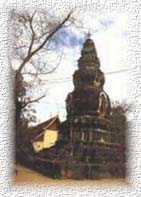
The chedi of Wat Ku-Tao was built in 1613 in the shape
of five guards of various sizes beautifuly decorated with colored porcelain
- representing five Lord Buddhas. People disagree on whether the unusual
chedi resembles a stack of five pumpkins or five alms bowls in ascending
sizes. But one thing is for sure, behind the walls guarded by celestial
lions, the main appeal of the temple is its peace as savoured under the
banyan tree.
Wat
Chiang Man
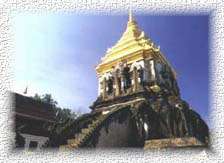 Built
in 1296 (the year Chiang Mai was founded), Wat Chiang Man (the Power of
the City) is Chiang Mai's oldest temple - the name suggesting its importance
for the early inhabitants of the city. The courtyard indeed served as residence
to King Mengrai, the founder of Chiang Mai. Today the temple is noteworthy
for a chedi supported by rows of elephant buttresses, and several
handsome bronze Buddha images from the Lanna period inside the viharn. Built
in 1296 (the year Chiang Mai was founded), Wat Chiang Man (the Power of
the City) is Chiang Mai's oldest temple - the name suggesting its importance
for the early inhabitants of the city. The courtyard indeed served as residence
to King Mengrai, the founder of Chiang Mai. Today the temple is noteworthy
for a chedi supported by rows of elephant buttresses, and several
handsome bronze Buddha images from the Lanna period inside the viharn.
Wat
Chedi Luang
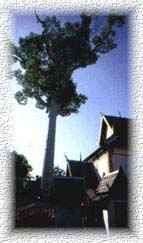 Wat
Chedi Luang, maybe the most impressive temple of Chiang Mai, is known for
its huge chedi. Built in 1401 and raised to a height of 86m in 1454
by King Tilokaraja (the founder of Wat Chet
Yot), it was partially destroyed and reduced
to its present height of 42m during a massive earthquake in 1545. Another
feature of the site is the tall gum tree that lies just inside its entrance.
According to legend, the fate of the tree is linked to that of the city
: when the tree falls, so will Chiang Mai. Also of interest are a Naga (serpent)
staircaise adorning the main chapel's front porch, and the framed pictures
along the walls with English captions explaining the story of the Buddha's
life. Wat
Chedi Luang, maybe the most impressive temple of Chiang Mai, is known for
its huge chedi. Built in 1401 and raised to a height of 86m in 1454
by King Tilokaraja (the founder of Wat Chet
Yot), it was partially destroyed and reduced
to its present height of 42m during a massive earthquake in 1545. Another
feature of the site is the tall gum tree that lies just inside its entrance.
According to legend, the fate of the tree is linked to that of the city
: when the tree falls, so will Chiang Mai. Also of interest are a Naga (serpent)
staircaise adorning the main chapel's front porch, and the framed pictures
along the walls with English captions explaining the story of the Buddha's
life.
Wat Phra
Sing
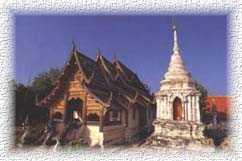 Wat
Phra Sing, Chiang Mai's most famous temple after Doi Suthep - and probably
the most lovely, dates from 1345. The temple compound includes the Lai
Kham chapel with exquisite woodcarvings and murals, and a repository with striking base relief. The beautiful library is a Lanna-style
building with stucco angels that convey tranquility and delicacy. Behind
the viharn is a wooden bot with a stunning stucco and gold
entrance. Behind is a Sukhotai style chedi built by King Pha Yu
to hold the ashes of his father. Wat
Phra Sing, Chiang Mai's most famous temple after Doi Suthep - and probably
the most lovely, dates from 1345. The temple compound includes the Lai
Kham chapel with exquisite woodcarvings and murals, and a repository with striking base relief. The beautiful library is a Lanna-style
building with stucco angels that convey tranquility and delicacy. Behind
the viharn is a wooden bot with a stunning stucco and gold
entrance. Behind is a Sukhotai style chedi built by King Pha Yu
to hold the ashes of his father.
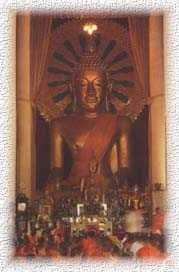
Inside Wat Phra Sing.
 e-mail
: cmct@chiangmai-online.com e-mail
: cmct@chiangmai-online.com
[Chiang Mai Carnival Tour T.A.T. LICENSE 23-0137
chiangmai-carnival.com]
 
chiangmai,chiang,thailand,travel,tour,northern
thailand,hotel,rafting,hilltribe,golden triangle,elephant,temple,car rent,doi
suthep,chiangmai,chiang,thailand,travel,tour,northern thailand,hotel,rafting,hilltribe,golden
triangle,elephant,temple,car rent,doi suthep,chiangmai,chiang,thailand,travel,tour,northern
thailand,hotel,rafting,hilltribe,golden triangle,elephant,temple,car rent

|